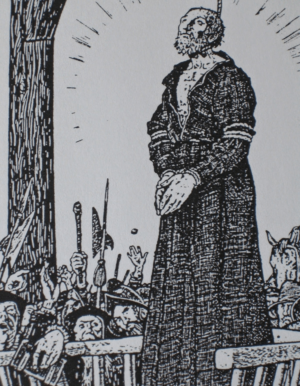John Story (martyr) facts for kids
Quick facts for kids BlessedJohn Storey |
|
|---|---|
 |
|
| Martyr | |
| Born | 1504 Northumberland, England |
| Died | 1 June 1571 Tyburn, London, England |
| Venerated in | Roman Catholic Church |
| Beatified | 29 December 1886, Rome by Pope Leo XIII |
| Feast | 1 June |
John Story (also known as John Storey) was an important English person who lived from 1504 to 1571. He was a Roman Catholic and a martyr, meaning he died for his religious beliefs. He was also a Member of Parliament, which means he helped make laws for England.
John Story had to escape to another country called Flanders in 1563. But later, he was tricked onto a boat in Antwerp and taken back to England. He was put in the Tower of London and later executed in a place called Tyburn. He was accused of treason, which means being disloyal to the king or queen.
Contents
John Story's Early Life and Education
John Story was born in 1504. His parents were Nicholas and Joan Story, who lived in Salisbury, England. He became part of a religious group called the Secular Franciscan Order.
He studied at the University of Oxford. In 1535, he became a teacher of civil law. Civil law is about the rights of people and how they should act. Two years later, he became the head of Broadgates Hall. This college later became Pembroke College, Oxford.
In 1538, he earned his D.C.L. degree, which is a high degree in law. The next year, he left his job at Broadgates. He then became a lawyer, working at a place called Doctors' Commons. John Story was married to a woman named Joan Watts.
Changes in Beliefs and Political Life
At one point, John Story seemed to change his mind about his Roman Catholic faith. He took the Oath of Supremacy. This oath said that the English monarch, not the Pope, was the head of the Church in England.
In 1544, King Henry VIII recognized Story for his legal work. The King made him the Regius Professor of civil law at Oxford. This was a very important teaching job.
John Story was also chosen to be a Member of Parliament. He represented Salisbury in 1545. He also represented Hindon in Wiltshire.
Opposition to New Laws
When King Edward VI became king in 1547, John Story became well-known. He strongly disagreed with the Act of Uniformity in 1548. This law changed how church services were held in England.
Story famously said, "Woe unto thee, O land, when thy king is a child." Because of this, the House of Commons put him in prison. However, he was soon set free. After this, he and his family went to live in exile in Louvain. This city was in another country.
Return to England Under Queen Mary
When Queen Mary became queen in August 1553, John Story returned to England. His job as Regius Professor was offered to him again. But he decided to leave his position at Oxford.
Instead, he became a chancellor for the dioceses of London and Oxford. He also became a dean of arches. Queen Mary was a strong Catholic. Story helped her government in legal cases against people who did not follow the Catholic faith. He was also involved in the trial of Thomas Cranmer in Oxford in 1555.
Challenges Under Queen Elizabeth I
Under Queen Elizabeth, John Story was again elected to Parliament. He represented several areas, including East Grinstead in 1553 and Bath in 1554.
However, his strong Catholic beliefs caused problems. On May 20, 1560, he was put in Fleet Prison. He was jailed for refusing to attend public worship. He also spoke out against the new religion of England.
Escape, Capture, and Trial
In 1563, John Story was arrested again. He was sent to the Marshalsea prison. But he managed to escape to Flanders. There, he received money from King Philip II of Spain. He also helped other Catholic people who had left England.
The Duke of Alba, who governed the Spanish Netherlands, hired Story. His job was to stop books that went against Catholic beliefs from being sent from the Netherlands to England.
The Abduction and Imprisonment
In 1570, John Story was tricked. He was lured onto a trading boat in Antwerp. The boat then took him to Yarmouth in England. From there, he was sent to be imprisoned in the Tower of London.
Some people believed that Story's capture was a message. It showed how powerful Queen Elizabeth was. It also showed that Spain could not protect the English Catholics who had left their home country.
Trial and Execution
John Story said he was a Spanish subject. But he was put on trial for high treason. Treason means betraying your country. He was accused of supporting a rebellion in 1569. He was also accused of encouraging the Duke of Alba to invade England.
On May 2, 1571, he was found guilty and sentenced to death. St. Edmund Campion was at the trial. Seeing Story's trial made Campion think about his own Catholic duties.
John Story was executed at Tyburn on June 1, 1571. He was put to death in a very harsh way. Before he died, he gave a long speech. He also asked for help for his wife, who had four young children.
Veneration
In 1886, John Story was given the title of "Blessed" by Pope Leo XIII. This honor was first approved by Pope Gregory XVI in 1859.
See also
 In Spanish: John Story para niños
In Spanish: John Story para niños

